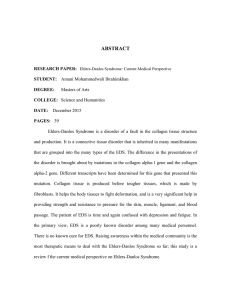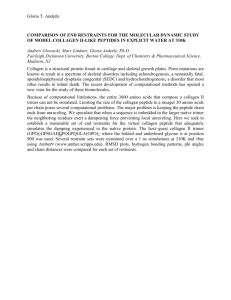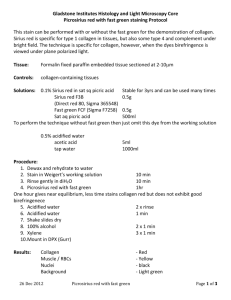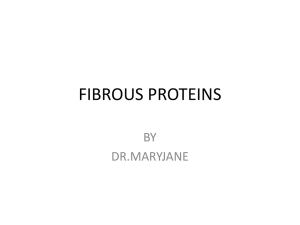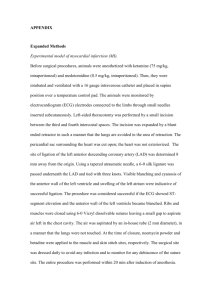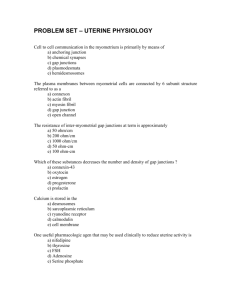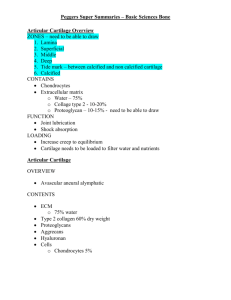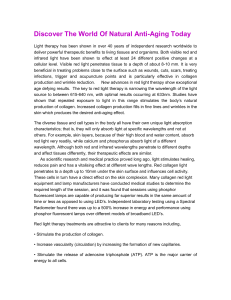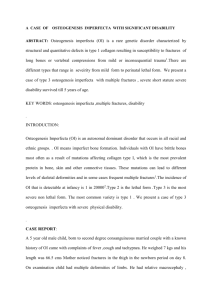Osteogenesis Imperfecta(1)
advertisement
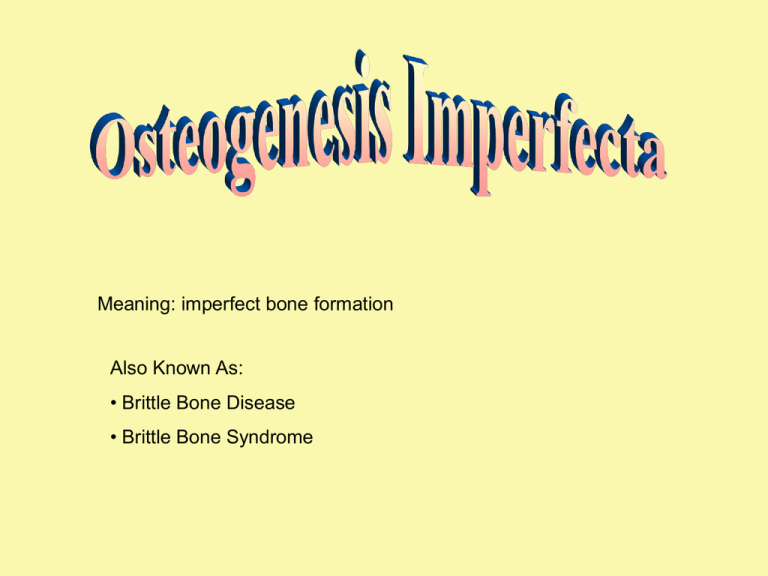
Meaning: imperfect bone formation Also Known As: • Brittle Bone Disease • Brittle Bone Syndrome How Common is it? A range of 25,000 to 50,000 Americans are affected by OI. This wide range is due to the fact that very mild cases of OI often go unnoticed and are not diagnosed. Worldwide, about 1 in every 20,000 people have OI. Generally, it is a rare disease. Q: WHAT IS OSTEOGENESIS IMPERFECTA? A: OI is a genetic disorder the affects the gene that produces collagen in your body. Collagen is a protein that connects tissues in your body. It also helps with the formation of teeth, ligaments, and sclera (white outer tissue of the eyeball). By looking at a person, you MAY be able to tell if they had OI by their abnormally small stature, the whites of their eyes being a blue color, they would have a triangular head shape, and could potentially be using a walker, wheelchair, or have casts on at the time. However, some people with OI have relatively mild symptoms and you MAY NOT notice that they look different in any way. SYMPTOMS: multiple, frequent fractures muscle weakness joint laxity curved bones Scoliosis brittle teeth short stature blue sclera fragile skin triangular head and face shape respiratory complications WHO? How does OI affect a Basedperson’s on the type life? of OI, a person’s lifespan could be affected very little, while it can also be drastically affected. There are 8 different types of OI. Similar symptoms may occur in all types of OI with varying severity. Different symptoms may also show How does OI affect a CONTIN UED… TYPE I: mildest and most common form of disorder; does not usually affect lifespan unless a severely traumatic event occurs; most fractures occur during youth and adolescence TYPES II and III: most severe types; infants with TYPE II commonly die during pregnancy or shortly after birth , however some with TYPE III may survive longer but with many disabilities and traumatic events TYPES IV-VII: moderate forms of disease; lifespan not dramatically affected; more rare than type I and deal with different genes TYPE VIII: more severe type similar to types II or III but some symptoms vary *There is no certain reduced life expectancy, but with more severe cases of OI the probability of death from accidental trauma or respiratory complications is highly increased. -Respiratory problems and accidental trauma are the most common deaths of people who have OI. Can a person be tested OI? YES. Testing can take place to make a diagnosis if a person is showing symptoms of OI. Tests can also be planned for children whose families have been affected by OI. Testing and diagnosis is usually done during childhood, and a diagnosis can sometimes be made during pregnancy. Methods of testing include: o X-Rays o DNA sequencing using a collagen sample from blood o Biochemical tests using a collagen sample from the skin o tests during pregnancy can be done through ultrasound and amniocentesis for How is OI treated? There is no cure for OI as of right now. However, there are some ways of dealing with the disorder. Biophosphonates and other medicines are used to make bones stronger and more dense, and surgically placing rods in the bones of the legs often help prevent major fractures. There are minor symptoms of the biophosphonates, including stomach upset and heartburn. On a regular basis, doctors and families focus on mobility and safe exercise such as swimming and physical therapy, as well as keeping fracture numbers to a minimum. Braces, wheelchairs, and casts are useful aids as well. Support Groups The Osteogenesis Imperfecta Foundation is a major organization that helps educate people about OI. It also gives reference to several people whom you can contact about local support groups near you. Inheritance Patterns and Gene Location Dominant or Recessive? About 85%-90% of OI cases that are inherited are inherited in dominant manner. There are some rare instances where the disorder is recessive an autosomal however. The different inheritance patterns may also deal with slightly different genes. 35% of OI cases are a result of spontaneous mutations, while the others come from parents affected by OI or parents who are carriers. The mutations that cause collagen problems can affect either the quantity of collagen or the quality of the collagen produced. Inheritance Patterns and Gene Location Continued… The gene for Osteogenesis Imperfecta is located on chromosome 17 which has 81 million base pairs. INTERESTING FACTS *Parents of children with OI are often accused of child abuse, which is why they are advised always to carry a document stating their child’s condition so that their kids aren’t taken from them at any point. *OI was recognized in an Egyptian mummy that is dated back to 1000 BC. *OI does not affect fertility. *The 2 forms of OI that are inherited recessively were discovered only 4 year ago. oif.org genome.gov orthoinfo.aaos.org Dnarss.com Ghr.nlm.nih.gov
